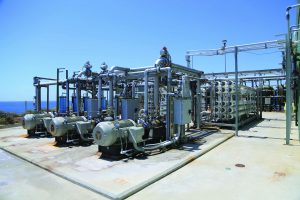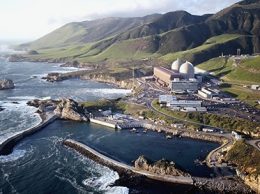San Luis Obispo County thirsty for desalination partnership
IN THIS ARTICLE
- Central Coast Topic
- Elijah Brumback Author
By Elijah Brumback Friday, June 19th, 2015
California’s continued drought is helping build the case for costly desalination plant reboots and entirely new projects up and down the coast.
In San Luis Obispo County, Third District Supervisor Adam Hill said a possible plan to use excess desalinated water production capacity at the Diablo Canyon nuclear power plant to replenish south county aquifers is the strongest proactive measure to address water woes in the region.
“If we can buy enough water to take care of one part of our county’s ground basin, I think that would be a huge step forward for the community,” Hill told the Business Times. “We’re only talking about desal because we’re a coastal community and have a facility here already.”
The possibility of connecting Diablo Canyon’s desal plant by pipeline to the south county isn’t a final solution, but would relieve a lot of anxiety and safety concerns, Hill said.
Other conservation measures, including establishing a collective grey water system that could be used to recycle water from sinks, showers, tubs, and washing machines and used on landscaping, should be part of the plan, Hill said.
Hill and Fourth District Supervisor Lynn Compton head the county’s Drought Task Force and are keen on tapping into the 1.5 million gallons Diablo Canyon’s desal plant is licensed to produce.
Pacific Gas and Electric Co. only uses about 675,000 gallons daily for operations at the power plant, leaving the opportunity to pump 825,000 gallons a day into the county.
At the San Luis Obispo County Board of Supervisors meeting on May 19, the county approved a contract with PG&E that allows it to buy some of Diablo Canyon’s excess desalinated water — at a cost of $3.34 per 1,000 gallons — for firefighting uses during a wildfire emergency. During that same meeting, the county also approved a feasibility study that would outline a number of options, the cost and the infrastructure needed to pipe the water to the south county.
While it is premature to discuss any findings, Tom Cuddy, senior manager of corporate relations for PG&E, said the possibility of piping excess water has long been discussed but only in the last year have those talks become more involved.
“It’s a considerable amount of water to be used and our focus right now, with the drought further intensifying, is to support the community and ensure its safety,” Cuddy said. “No. 1, we want people to be able to rest easy at night knowing there is a reliable and ready supply of water. The thing is we live and work in the community, too, and we look forward to working with the county going forward.”
In perspective, 825,000 gallons of water could go a long way. The average San Luis Obispo resident uses about 108 gallons of water per day. With the desal plant at full production, more than 7,600 residents could be covered.
According to Cuddy, PG&E is more than willing to beef up the operation. Even though the cost to operate the facility is increased due the extra electricity needs, that cost is negligible to PG&E because it’s already generating the power that would be needed. Additional upgrades, including new filter systems, which can can cost as much $6,000 a piece, would be needed as well.
Building a pipeline to the south county, which is essentially the plan’s biggest hurdle, appears to have good timing. PG&E said previously it has plans to upgrade utility lines along the plant’s main access road from Avila Beach and that could provide an opportunity to install a new water pipeline.
Hill said more details from the feasibility study are expected on Aug. 25 and Sept. 15 at the latest.
SLO County isn’t alone in its quest to make use of existing desalination facilities.
On June 16, the Santa Barbara City Council agreed to spend $3.7 million on the design phase of rebooting its desal facility, which could cost about $55 million to relaunch and about $4 million annually to operate. The cost is huge but, according to city officials, its the only option Santa Barbara has.
In Carlsbad, Boston-based Poseidon Water, a developer of desalination facilities, is slated to open a $1 billion desalination plant. Upon completion it will be the largest in North America, capable of producing 54 million gallons of water each day.
According to a report from the Wall Street Journal, local residents and politicians in San Diego and Orange County have voiced concerns over desalination’s high costs. Under the terms of the purchase agreement with Poseidon, the desalinated water will cost San Diegans between $2,014 and $2,257 per acre foot (roughly 0.6 to 0.7 cents per gallon), or about twice as much as importing water from the Sierra Nevadas, according to the report.
Because it’s California, where electricity and labor cost more than in most states and where lengthy regulatory requirements balloon construction costs, building these facilities has inherent challenges.
Whether or not either project locally gets the go ahead is still uncertain, but if the drought wears on, as many already expect it will, officials said there really won’t be any other option.











